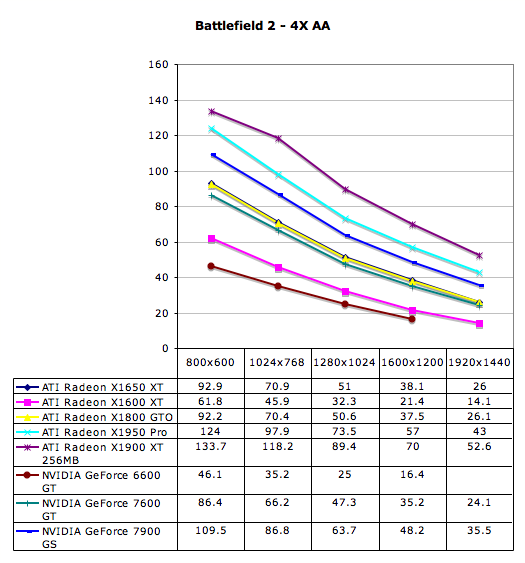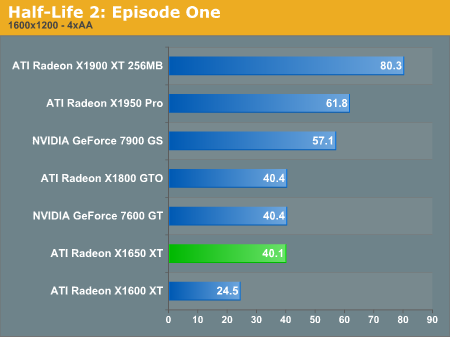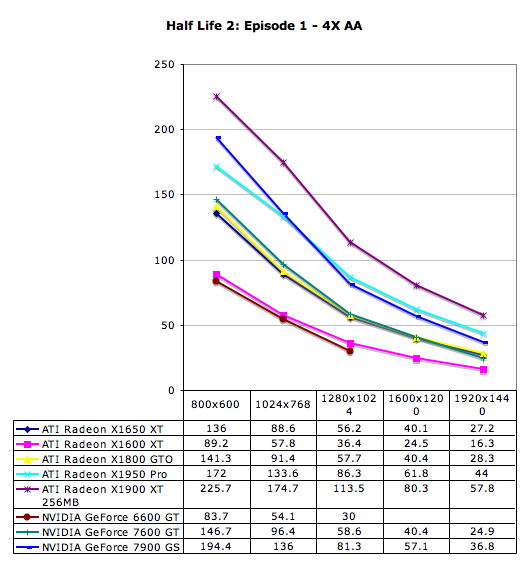Introducing the Radeon X1650 XT: A New Mainstream GPU from ATI
by Josh Venning on October 30, 2006 6:00 AM EST- Posted in
- GPUs
Antialiasing Performance
We also tested a couple of these games with 4xAA enabled in order to see how well the X1650 XT deals with AA. Antialiasing is something that is interesting to talk about, and is generally a tool for cleaning up the in-game picture. AA softens edges in a 3D environment, and hides the jaggies that can sometimes appear along them. One of the oddities about AA is that it's more important and effective when gaming at lower resolutions, which is going to be more of a necessity on low-end cards. This creates a dilemma because AA can create a significant performance hit when enabled. We find it's generally better to increase the resolution rather than use AA, but this will vary depending on user preference.
AA is a good solution for people with LCD panels that don't go above 1280x1024, in which case AA would be the only way to increase the graphical quality of a game. Also for those who don't have enough horsepower to move up to a higher resolution, turning on a little AA might be a way to get a little better image quality. Some gamers out there are just plain addicted to AA, but for lower end and mainstream parts the performance isn't always there. Let's see how things stack up.




Something that jumps out at us here is that the X1650 XT got slightly better performance at the highest resolution than the 7600 GT in both of these games with 4xAA enabled. Without AA enabled, the 7600 GT did better than the X1650 XT in these games. The amount of difference between the performance of both of these cards is about the same with and without AA at 1920x1440. Without AA enabled the 7600 GT generally performs a few frames better across resolutions in Battlefield 2; with AA enabled the X1650 XT generally performs a few frames better. This is interesting but makes sense when we consider that ATI generally performs better with AA enabled than NVIDIA does.
We also tested a couple of these games with 4xAA enabled in order to see how well the X1650 XT deals with AA. Antialiasing is something that is interesting to talk about, and is generally a tool for cleaning up the in-game picture. AA softens edges in a 3D environment, and hides the jaggies that can sometimes appear along them. One of the oddities about AA is that it's more important and effective when gaming at lower resolutions, which is going to be more of a necessity on low-end cards. This creates a dilemma because AA can create a significant performance hit when enabled. We find it's generally better to increase the resolution rather than use AA, but this will vary depending on user preference.
AA is a good solution for people with LCD panels that don't go above 1280x1024, in which case AA would be the only way to increase the graphical quality of a game. Also for those who don't have enough horsepower to move up to a higher resolution, turning on a little AA might be a way to get a little better image quality. Some gamers out there are just plain addicted to AA, but for lower end and mainstream parts the performance isn't always there. Let's see how things stack up.




Something that jumps out at us here is that the X1650 XT got slightly better performance at the highest resolution than the 7600 GT in both of these games with 4xAA enabled. Without AA enabled, the 7600 GT did better than the X1650 XT in these games. The amount of difference between the performance of both of these cards is about the same with and without AA at 1920x1440. Without AA enabled the 7600 GT generally performs a few frames better across resolutions in Battlefield 2; with AA enabled the X1650 XT generally performs a few frames better. This is interesting but makes sense when we consider that ATI generally performs better with AA enabled than NVIDIA does.










33 Comments
View All Comments
LuxFestinus - Monday, October 30, 2006 - link
One nice thing about the X1650 XT is that is doesn't require an external power connection. The second "is" should be "it" please. Thank you.Josh Venning - Monday, October 30, 2006 - link
It's been fixed. Thankstrabpukcip - Monday, October 30, 2006 - link
I think they meant the 7600GT doesn't require an external power connector.
I sure remember hooking up the power connector for my little brother's 7900GS less than five metres from me, being derived from a crippled 7900GT and all.
And as for you you American dotted underline spellchecker. I spell it metres NOT meters where I come from ;). (It even underlined "spellchecker", the irony).
bldckstark - Monday, October 30, 2006 - link
What colour was the underline?DerekWilson - Monday, October 30, 2006 - link
lolJarredWalton - Monday, October 30, 2006 - link
Back to the original comment, this has been corrected. Unless Josh knows something I don't, all of the 7900 GS cards I can find require a PCIe power connector. 7600 GT does not, however. Odd, considering power draws are about the same.BigLan - Monday, October 30, 2006 - link
What's the avivo performance of the x1650xt? Can it handle acceleration of 1080i/p stuff, or is it limited to 720p like it's predecessor? If it can only do 720p it's taking a huge hit against the 7600gt which has full purevideo compatibility (and is the current darling of the htpc crowd.)Also, I haven't heard anything about gpu accelerated transcoding in a while. Any chance of getting an anandtech article about it using non-beta versions?
blckgrffn - Monday, October 30, 2006 - link
An incomplete specifications table, assertions like "it has twice the pixel pipelines, 12 to 24 which will fix the performance issues" when really the x16xx family was plagued by a fill rate comparable to a 9600XT.Don't take this personal Josh - but Anandtech is supposed to have the definitive review, not simply an adequate one.
Nat
DerekWilson - Monday, October 30, 2006 - link
We had trouble tracking down the # of vertex and color/z pipes -- we didn't want to comment on any fill rate differences until we could confirm our suspicions -- raster pipes have doubled, and this definitely helps at higher resolutions and with AA or stencil shadows, etc...But doubling the pixel pipes does allow them to get a big boost in performance without upping the clock speed in more modern games (like oblivion) where fill rate wasnt as large an issue.
Sorry for the gap in the article -- it has been updated and a paragraph has been added after our charts to explain the impact of raster pipes. In the future, we'll be sure to get ahold of the data we need in a more timely fashion.
Derek Wilson
blckgrffn - Tuesday, October 31, 2006 - link
Thanks!Anandtech is my homepage, and will continue to be for some time. Really, I think we all just want to see this site be the best that it can be.
Nat